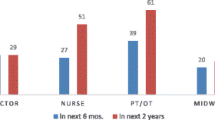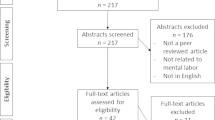Abstract
Since aging-in-place is the preferred choice for many older adults, employing in-home caregivers to look after them is an emerging practice in Canada. The Live-in Caregiver Program (LCP), established by Citizenship and Immigration Canada, allows Canadians to employ qualified foreign workers in their private residence, for care of children, the elderly, the sick and persons with disabilities. While the LCP has been researched from various critical viewpoints focusing on workers’ rights, relatively few studies have examined the program from other perspectives, and even fewer have focused exclusively on LCP caregivers who provide long term care to older adults. This study attempts to enhance our understanding of the characteristics of LCP elder care workers, and their older adult clients. It also explores the care-providers’ job trajectory and their job and life satisfaction over time. Fourteen migrant long term care workers were interviewed in 2009 and five again in 2011. In both the initial and follow-up interviews job satisfaction was assessed through open-ended questions and through administration of a scale adapted by Grau et al. (Journal of Aging and Health 3: 47, 1991). In addition to reflecting the challenges identified in previous research, this study provides a glimpse of the achievements, sense of reward and empowerment workers experienced through participating in the LCP, and its relative attractiveness to care-workers who often have transnational experiences against which to compare its benefits and drawbacks.




Similar content being viewed by others
Notes
“Long-term care is the care provided to those who need assistance with activities of daily living (ADL), that is, bathing, dressing, toileting, transfer, ambulation, and eating” (Browne and Braun 2008b, p173)
The minimum wage in British Columbia was $8/h in 2009 (source: http://www2.news.gov.bc.ca/news_releases_2009-2013/2011LCITZ0007-000353.htm). The wage of the current LCP workers follows the current minimum wage in BC, which is $10.25 (source: http://www.hrsdc.gc.ca/eng/workplaceskills/foreign_workers/advertReq/wageadreq.shtml#tphp)
References
AARP. (2003). These four walls: Americans 45+ talk home and community. Washington, DC: AARP.
Arat-Koc, S. (1997). From Mothers of the Nation to migrant workers. In A. Bakan & D. Stasiulis (Eds.), Not one of the family: Foreign domestic workers in Canada (pp. 53–79). Toronto: University of Toronto Press.
Arat-Koc, S. (1999). Good enough to work but not good enough to stay: Foreign domestic workers and the law. In E. Comack (Ed.), Locating law: Race/class/gender connections (pp. 125–151). Halifax: Fernwood Publishing.
Bakan, A., & Stasiulis, D. (1997). Not one of the family: Foreign domestic workers in Canada. Canada: University of Toronto Press.
Bourgeault, I., Parpia, R., & Atanackovic, J. (2010). Canada’s live-in caregiver program: is it an answer to the growing demand for elderly care? Journal of Population Ageing, 3, 83–102. doi:10.1007/s12062-010-9032-2.
Bourgeault, I., Atanackovic, J., Rashid, A., & Parpia, R. (2010). Relations between immigrant care workers and older persons in home and long-term care. Canadian Journal on Aging, 29(1), 109–118.
Browne, C., & Braun, K. (2008a). Globalization, women’s migration, and the long-term care workforce. Gerontologist, 48(1), 16–24.
Browne, C., & Braun, K. (2008b). Immigration and the direct long-term care workforce: implications for education and policy. Gerontology and Geriatric Education, 29(2), 172–188. doi:10.1080/02701960802223274.
Browne, C., Braun, K., & Arnsberger, P. (2007). Filipinas as residential long-term care providers: influence of cultural values, structural inequity, and immigration status on choosing this work. Journal of Gerontological Social Work, 48(3/4), 439–455. doi:10.1300/J083v48n03_10.
Buhler, S. (2006). Is better good enough? Canada’s Live-in Caregiver Program. Human Rights Tribune, 12(1).
Cantor, M., & Chichin, E. (1990). Stress and strain among the homecare workers of the frail elderly. New York: Brookdale Research Institute of Aging.
Chang, K., & Ling, L. (1999). Globalization and its intimate other: Filipina domestic workers in Hong Kong. In M. Marchand & A. Runyan (Eds.), Gender and global restructuring: Sightings, sites, and resistance (pp. 27–43). NewYork: Routledge.
Cheng, S. A. (2003). Rethinking the globalization of domestic service: foreign domestics, state control, and the politics of identity in Taiwan. Gender and Society, 17, 166–186.
CIC (2011a). Hiring a live-in caregiver: Who can apply? Retrieved Nov 14, 2011 from http://www.cic.gc.ca/english/work/apply-who-caregiver.asp.
CIC (2011b). Temporary foreign worker program: Immigration and refugee protection regulations amendments — live-in caregiver program. Retrieved Nov 14, 2011 from http://www.hrsdc.gc.ca/eng/workplaceskills/foreign_workers/lcp_irpr.shtml.
CIC (2011c). News release — New rules to strengthen the temporary foreign worker program. Retrieved Nov 14, 2011 from http://www.cic.gc.ca/english/department/media/releases/2011/2011-03-24a.asp.
CIC (2011d). Backgrounder — Four-year limit for foreign nationals working in Canada. Retrieved Nov 14, 2011 from http://www.cic.gc.ca/english/department/media/backgrounders/2011/2011-03-24.asp.
CIC (2011e). News release — Minister Kenney announces important change for live-in caregivers. Retrieved Dec 27, 2011 from http://www.cic.gc.ca/english/department/media/releases/2011/2011-12-15.asp.
CIC (2012). The live-in caregiver program: Who can apply? Retrieved September 26 from http://www.cic.gc.ca/english/work/caregiver/apply-who.asp.
Constable, N. (2007). Maid to order in Hong Kong: Stories of migrant workers. USA: Cornell University Press.
Depatie-Pelletier, E. (2008). Under legal practices similar to slavery according to the U.N. Convention: Canada’s “non white” “temporary” foreign workers in “low-skilled” occupations. Paper presented at 10th National Metropolis Conference, Halifax. Retrieved February 12, 2012 from https://www.cerium.ca:488/IMG/pdf/Article_Depatie-Pelletier_Metropolis_2008.pdf.
Döhner, H., Lüdecke, D., & Eickhoff, V. (2008). Migrant workers in home care for older people in Germany: The use and problems of legal and irregular care. Paper presented at III Symposium on Social and Applied Gerontology, Antalya, Turkey.
Elrick, T. (2008). Matching and making labour demand and supply: agents in Polish migrant networks of domestic elderly care in Germany and Italy. Journal of Ethnic and Migration Studies, 34(5), 717–734.
George, U. (2006). Immigration and refugee policy in Canada: Past, present and future. In A. Westhues (Ed.), Canadian social policy: Issues and perspectives (pp. 349–457). Waterloo: Wilfrid Laurier University Press.
Grandea, N., & Kerr, J. (1998). Frustated and displaced: Filipina domestic workers in Canada. Gender & Development, 6(1), 7–12.
Grau, L., Chandler, B., Burton, B., & Kolditz, D. (1991). Institutional loyalty and job satisfaction among nurse aides in nursing homes. Journal of Aging and Health, 3, 47. doi:10.1177/089826439100300103.
Grau, L., Colombotos, J., & Gorman, S. (1992). Psychological morale and job satisfaction among home care workers who care for persons with AIDS. Women & Health, 18(1), 1–21.
Hodge, J (2006). “Unskilled labour”: Canada’s live-in caregiver program. Undercurrent, III (2).
HRSDC (2011). Temporary foreign worker program: Immigration and refugee protection regulations amendments — live-in caregiver program. Retrieved Nov 14, 2011 from http://www.hrsdc.gc.ca/eng/workplaceskills/foreign_workers/lcp_irpr.shtml.
HRSDC (2012). Temporary foreign worker program: Live-in caregiver program. Retrieved Feb 10, 2012 from http://www.hrsdc.gc.ca/eng/workplaceskills/foreign_workers/lcpdir/lcpone.shtml.
Iecovich, E. (2007). Who will care for the frail elderly persons: The challenge of globalization. In I. Tufan (Ed.), Proceedings book of the 2nd international symposium on social and applied gerontology in Turkey (pp. 321–334). Antalya: GeroYay Publishing.
Iecovich, E. (2011). What makes migrant live-in home care workers in elder care be satisfied with their job? The Gerontologist, 51(5), 617–629.
Khan, S. A. (2009). From labour of love to decent work: protecting the human rights of migrant caregivers in Canada. Canadian Journal of Law and Society, 24, 23–45.
Korczyk, S. (2004). Long-term care workers in five countries: Issues and options. Washington, DC: AARP Public Policy Institute.
Lamura, G., Polverini, F., Melchiorre, M. (2006). Migrant care workers in long-term care: Lessons from the Italian case. Paper presented at Academy Health Annual Research Meeting. Seattle, USA.
Langevin, L., & Belleau, M. (2000). Trafficking in women in Canada: A critical analysis of the legal framework governing immigrant live-in caregivers and mail-order brides. Status of Women Canada.
Lauby, J., & Stark, O. (1988). Individual migration as a family strategy: young women in the Philippines. Population Studies, 42, 473–486.
Lindsay, L. B., Martin, S., & Stone, R. (2012). Ageing and care giving in the United States: policy contexts and the immigrant workforce. Journal of Population Ageing, 3(1), 59–82. doi:10.1007/s12062-010-9029-x.
Maruja, A. (2005). Caring for the world: Filipino domestic workers gone global. In S. Huang, B. Yeoh, & N. Rahman (Eds.), Asian Women as Transnational Domestic Workers (pp. 21–53). Singapore: Marshall Cavendish Academic.
Maruja, A., Huang, S., & Yeoh, B. (2004). When the light of the home is abroad: unskilled female migration and the Filipino family. Singapore Journal of Tropical Geography, 25(2), 198–215. doi:10.1111/j.0129-7619.2004.00182.x.
Miller, M. (2010). Claiming a life of permanence: Filipina caregivers’ migration experiences in Canada’s live-in caregiver program. Montreal: McGill University. Retrieved December 10, 2011 from http://proquest.umi.com/pqdlink?Ver=1&Exp=02-25-2017&FMT=7&DID=2386319231&RQT=309&attempt=1&cfc=1.
Oxman-Martinez, J. (2004). Another look at the live-in-caregivers program: An analysis of an action research survey conducted by PINAY, the Quebec filipino women’s association with the centre for applied family studies. Montreal: Centre de recherché interuniversitaire deMontreal sur l’immigration, l’integration et la dynamique urbaine.
Parreñas, R. S. (2001). Servants of globalization: Women, migration, and domestic work. California: Stanford University Press.
Parreñas, R. S. (2008). The force of domesticity: Filipina migrants and globalization. New York: New York University Press.
Pearson, C. (2009). High hope dashed: Canada’s live-in caregiver program. Our Times, 28(1), 10–17.
Pedraza, S. (1991). Women and migration: the social consequences of gender. Annual Review of Sociology, 17, 303–325.
Pratt, G. (1999). From registered nurse to registered nanny: Discursive geographies of Filipina domestic workers in Vancouver, B.C. Economic Geography, 75(3), 215–308.
Pratt, G., PWC (2003). From migrant to immigrant: Domestic workers settle in Vancouver, Canada. Research on Immigration and Integration in the Metropolis. Working Paper Series No. 03–18. Vancouver:RIIM.
Pratt, G., PWC (2008). Deskilling across the generations: Reunification among transnational Filipino families in Vancouver. Research on Immigration and Integration in the Metropolis, Working Paper Series No. 08-06. Vancouver,RIIM.
Redfoot, D., & Houser, A. (2005). “We shall travel on”: Quality of care, economic development, and the international migration of long-term care workers. Washington, DC: AARP Public Policy Institute.
Shannon, D. (2004). Respect for nannies: Live-in caregivers in Montreal. Our Times, 23(1), 33.
Spitzer, D. L. (2006). The land of milk and honey or dreams deferred”? An examination of foreign domestic care-workers in Canada. Paper presented June 9, 2006. National University of Singapore.
Spitzer, D. L. (2007). Embodying inequalities: Globalization, health and foreign domestic workers. Paper presented at the 12th International Metropolis Conference. Torino, Italy.
Spitzer, D. L. (2008). Live-in caregivers in rural and small city Alberta. Edmonton: The Prairie Metropolis Centre.
Spitzer, D., Torres, S. (2008). Gender-based barriers to settlement and integration for live-in caregivers: A review of the literature. CERIS Working Paper, No 71. Toronto: The Ontario Metropolis Centre.
Spitzer, D. L., Bitar, S., Kalbach, M., Bernardino, C., Pereira, I. I. (2002). In the shadows: Live-in caregivers in Alberta. Edmonton: Changing Together. ….A Centre for Immigrant Women.
Statistics Canada (2011). Canada’s population estimates: Age and sex. The Daily, September 28.
Stebbins, R. A. (2001). Exploratory research in the social sciences. Sage University Paper Series on Quantitative Research Methods, 48. Thousand Oaks, CA: Sage Publications.
Stebbins, R. A. (2008). Exploratory research. In L. Given (Ed.), The SAGE encyclopedia of qualitative research methods (pp. 327–329). Thousand Oaks: Sage Publications.
Stiell, B., & England, K. (1997). Domestic distinctions: constructing differences among paid domestic workers in Toronto. Gender, Place & Culture: A Journal of Feminist Geography, 4(3), 339–360.
Tung, C. (2000). The cost of caring: the social reproductive labor of Filipina live-in home health caregivers. Frontiers: A Journal of Women Studies, 21(1/2), 61–82.
Author information
Authors and Affiliations
Corresponding author
Additional information
This research was supported by an Emergent Needs Grant Program award from the British Columbia Network for Aging Research
Rights and permissions
About this article
Cite this article
Chowdhury, R., Gutman, G. Migrant Live-in Caregivers Providing Care to Canadian Older Adults: An Exploratory Study of Workers’ Life and Job Satisfaction. Population Ageing 5, 215–240 (2012). https://doi.org/10.1007/s12062-012-9073-9
Received:
Accepted:
Published:
Issue Date:
DOI: https://doi.org/10.1007/s12062-012-9073-9




